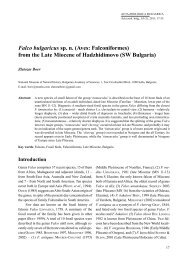Gyps bochenskii sp. n. (Aves: Falconiformes) from the Late ... - ecodb
Gyps bochenskii sp. n. (Aves: Falconiformes) from the Late ... - ecodb
Gyps bochenskii sp. n. (Aves: Falconiformes) from the Late ... - ecodb
You also want an ePaper? Increase the reach of your titles
YUMPU automatically turns print PDFs into web optimized ePapers that Google loves.
Boev Z.<br />
interphalangealis. Differences <strong>from</strong> G. copro<strong>the</strong>res<br />
are shown in <strong>the</strong> better developed fossa, larger size<br />
and <strong>the</strong> absence of a concave insertion on <strong>the</strong> medial<br />
edge of f. a. interphalangealis. It also differs <strong>from</strong> G.<br />
fulvus by thicker body of <strong>the</strong> phalanx e<strong>sp</strong>ecially before<br />
its articular part, deeper fossa on <strong>the</strong> lateral tip<br />
of <strong>the</strong> f. a., considerably blunter lateral tip of <strong>the</strong> f. a.,<br />
and <strong>the</strong> less concave caudal edge of <strong>the</strong> f. a.<br />
Phalanx dist. dig. I pedis sin., NMNHS 159<br />
Measurements: Table 6, Fig. 4 F.<br />
Comparison: The find differs <strong>from</strong> Aquilinae<br />
(Aquila, Haliaeetus, Harpia) by relatively shorter<br />
and more rounded base of <strong>the</strong> phalanx and less concave<br />
profile of <strong>the</strong> f. a. interphalangealis.<br />
It differs <strong>from</strong>: Necrosyrtes by much larger size<br />
and more protuberant and relatively short base of <strong>the</strong><br />
phalanx (measurement ‘c’); Sarcogyps by larger size<br />
and more open arc of <strong>the</strong> lateral profile of <strong>the</strong> bone;<br />
Torgos by larger size, less concave contours of <strong>the</strong> f.<br />
a. interphalangealis and more massive and round base<br />
of <strong>the</strong> phalanx; Trigonoceps by larger size and less<br />
developed collar around <strong>the</strong> f. a. in lateral view; and<br />
Aegypius by sharper shape of dorsal part of <strong>the</strong> f. a.,<br />
and less asymmetrical base of <strong>the</strong> phalanx. JANOSSY<br />
(1974) states that <strong>the</strong> pedal phalanges of G. melitensis<br />
are ‘very close to <strong>the</strong>se of A. monachus’ (p. 214)<br />
– ano<strong>the</strong>r distinguishing feature <strong>from</strong> G. melitensis);<br />
Gypaetus by bigger size and shorter and more rounded<br />
base of <strong>the</strong> phalanx. Gypaetus has a more elongated<br />
and sharper base of f. a. interphalangealis than in<br />
NMNHS 159. G. himalayensis was only partly compared<br />
because of <strong>the</strong> lack of complete skeletons of that<br />
<strong>sp</strong>ecies in <strong>the</strong> European collections. The only complete<br />
<strong>sp</strong>ecimen in <strong>the</strong> World (at NMNHW) is mounted<br />
(JAMES DEAN, NMNHW, in litt.) and does not allow<br />
reliable morphological comparisons. Partial skeletons<br />
in BMNH allowed <strong>the</strong> exclusion on morphological<br />
and taxonomical grounds of Varshets <strong>sp</strong>ecimens as<br />
belonging to G. himalayensis (see below).<br />
The find <strong>from</strong> Varshets resembles very much<br />
G. bengalensis, G. himalayensis and G. africanus<br />
in morphology, but it differs by its larger size, and<br />
<strong>the</strong> relatively bigger base of <strong>the</strong> phalanx. NMNHS<br />
159 also differs <strong>from</strong> G. africanus by sharper dorsal<br />
section of <strong>the</strong> f. a. interphalangealis. The similarities<br />
with G. bengalensis are considerable and <strong>the</strong> larger<br />
size of NMNHS 159 is <strong>the</strong> only difference. The find<br />
<strong>from</strong> Varshets differs <strong>from</strong> G. copro<strong>the</strong>res not only<br />
metrically, but also by more massive base of <strong>the</strong> phalanx.<br />
Differences <strong>from</strong> G. himalayensis are shown in<br />
<strong>the</strong> clearer (deeper) relief of <strong>the</strong> f. a. It differs <strong>from</strong><br />
G. fulvus by much longer (thicker) base (measurement<br />
‘d’, Table 6) and higher f. a. (measurement ‘b’).<br />
NMNHS 159 is considerably larger than G. indicus,<br />
G. tenuirostris and G. ruppellii and has a much more<br />
developed relief of <strong>the</strong> phalanx base. As RASMUSSEN<br />
& PARRY (2001) mention, <strong>the</strong> osteological differences<br />
between G. indicus and G. tenuirostris found in<br />
<strong>the</strong> shape of nares, thickness of neck, straightness of<br />
claws and length of tarsometatarsus and pedal digits,<br />
are more proportional than metrical.<br />
The remaining North-American vultures could<br />
be excluded of comparison both because of <strong>the</strong> considerable<br />
chronostratigraphical difference or <strong>the</strong><br />
geographical isolation and <strong>the</strong> considerable morphological<br />
differences. However, Neophrontops was<br />
both, morphologically and dimensionally close to<br />
<strong>the</strong> Old World Neophron (OLSON, 1985).<br />
The correlations between <strong>the</strong> metrical dimensions<br />
of <strong>the</strong> distal pedal phalanx of <strong>the</strong> 1st toe separates<br />
<strong>the</strong> fossil <strong>sp</strong>ecimen <strong>from</strong> all o<strong>the</strong>r <strong>sp</strong>ecies of<br />
genus <strong>Gyps</strong> (Fig. 7).<br />
Conclusions<br />
The systematic relationships among <strong>the</strong> griffon vultures<br />
are unclear. On both morphological and metrical<br />
grounds <strong>the</strong> fossil griffon vulture <strong>from</strong> Varshets<br />
is closer to recent G. fulvus than to Pleistocene G.<br />
melitensis, which may be a sou<strong>the</strong>rn-European/<br />
Mediterranean form of that <strong>sp</strong>ecies adapted to scavenging<br />
on terrestrial megafauna. The phylogenetic<br />
analyses with conservative estimates suggest a ‘recent<br />
and rapid’ diversification of <strong>Gyps</strong> taxa, occurring<br />
within <strong>the</strong> past 6 million years (JOHNSON et al.<br />
2006), a hypo<strong>the</strong>sis that is consistent with <strong>the</strong> fossil<br />
record. The genus <strong>Gyps</strong> has been determined ‘...<br />
unique among Old World vultures in that <strong>the</strong>y feed<br />
exclusively as scavengers...’. This <strong>sp</strong>ecialization<br />
evolved in close association with ungulate popula-<br />
236





